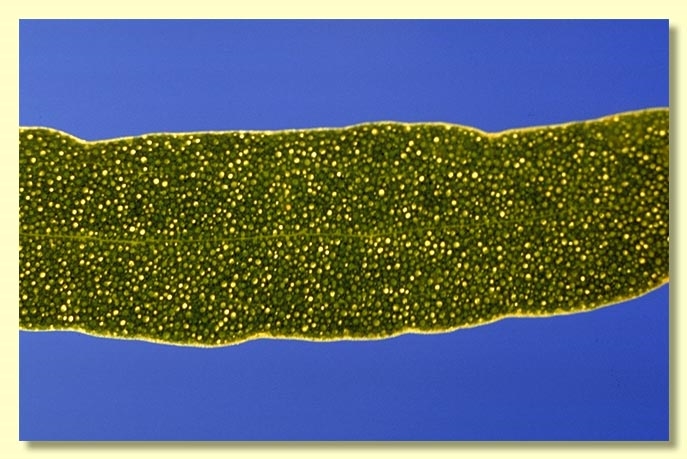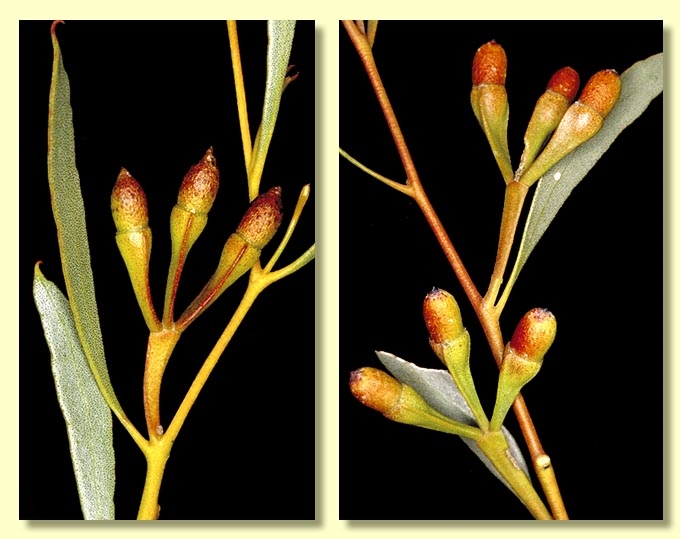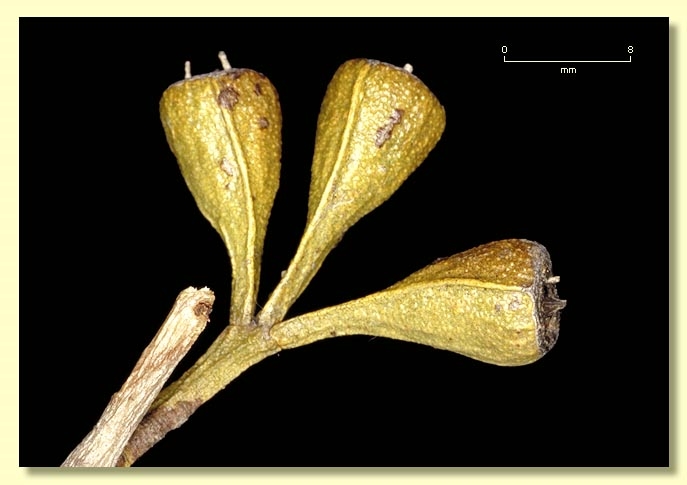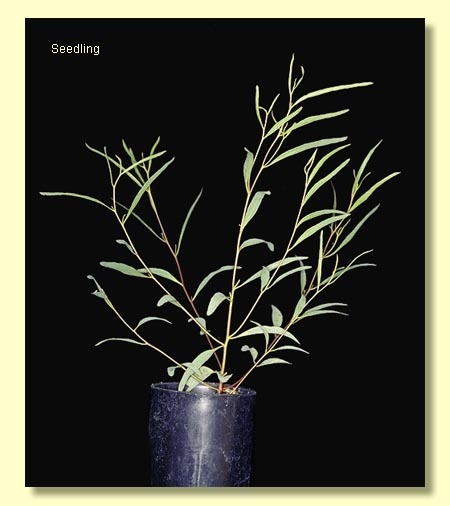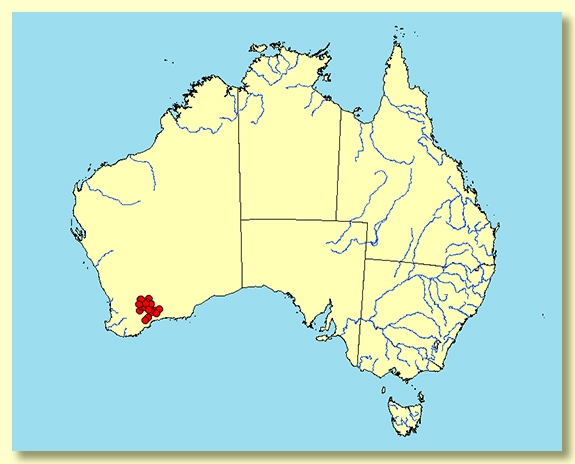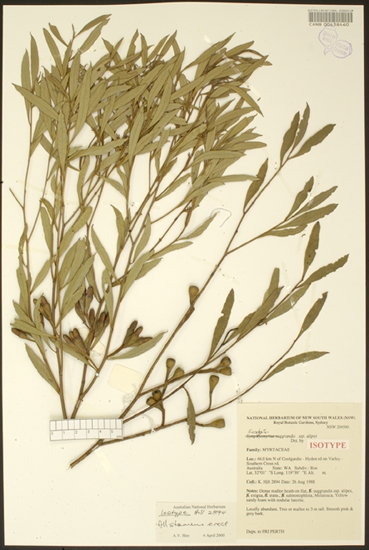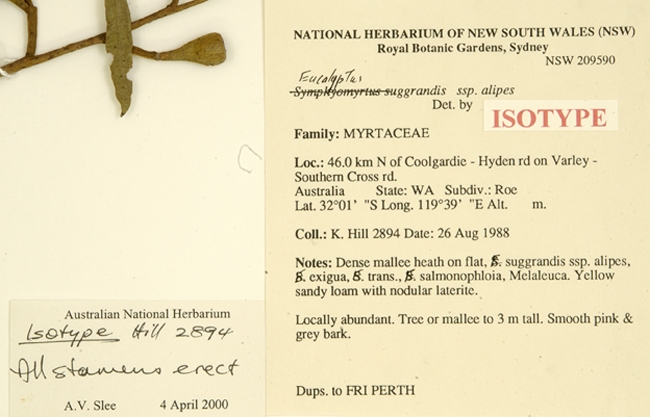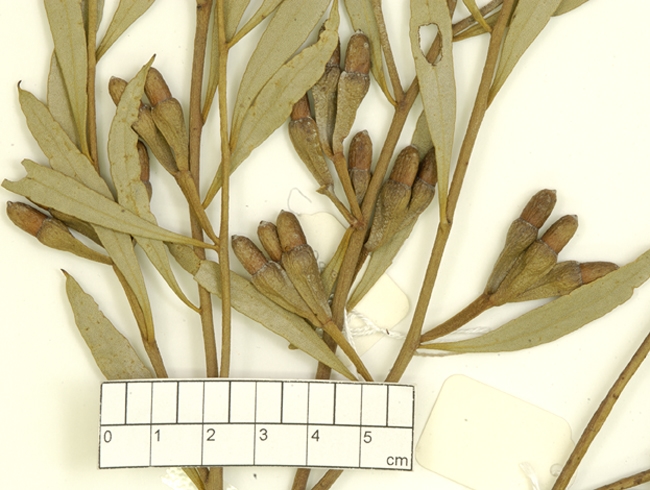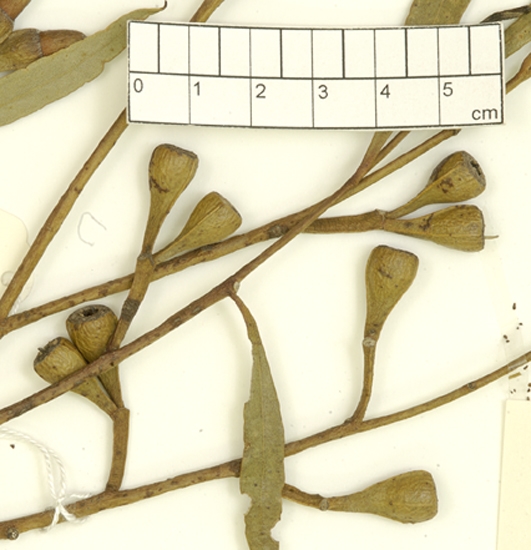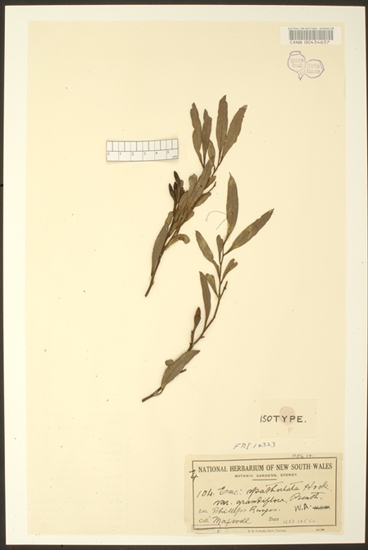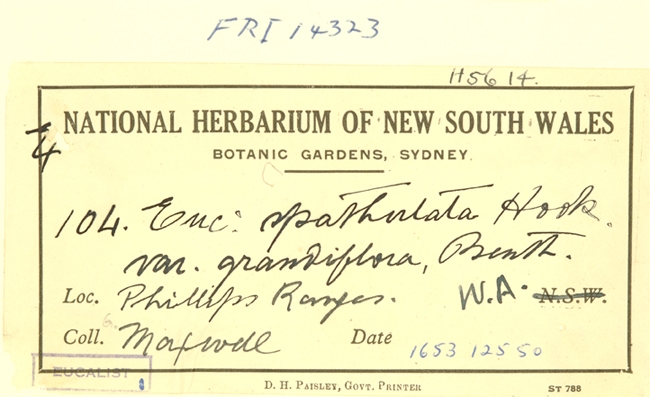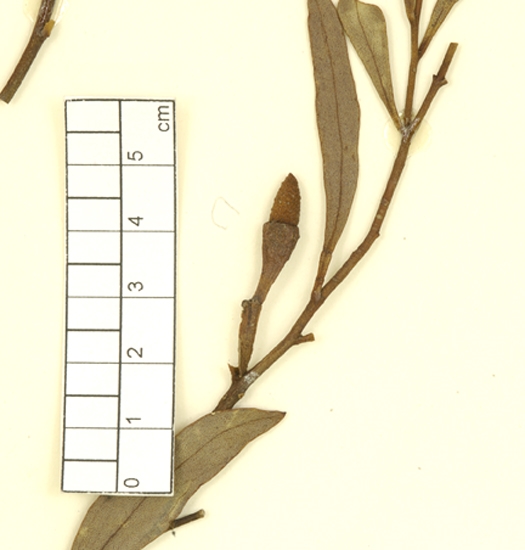Eucalyptus | Symphyomyrtus | Bisectae | Glandulosae | Erectae | Abundae
Euclid - Online edition
Eucalyptus alipes
Eucalyptus suggrandis subsp. alipes L.A.S.Johnson & K.D.Hill, Telopea 4: 581 (1992); T: Western Australia, 46.0 km N of Coolgardie – Hyden road on Southern Cross road, K.D.Hill 2894, 26 Aug 1988; holo: NSW; iso: CANB, PERTH.
Bark smooth throughout, pale shiny grey over grey-brown to bronze.
Branchlets have oil glands in the pith.
Juvenile growth (coppice or field seedlings to 50 cm): stems rounded in cross-section; juvenile leaves sessile to subsessile, held erect, opposite at lowest node then alternate, linear to narrowly elliptical, 4.5–8 cm long, 0.5–0.8 cm wide, margin entire or distantly notched, apex pointed, green, "glazed"; like adult foliage by ca 1m tall.
Adult leaves held erect, alternate, sessile or with petioles to 0.8 cm long; blade linear to narrowly elliptical, 3–7.5 cm long, 0.4–1.1 cm wide, base tapering to petiole, margin entire or distantly indented, apex pointed, concolorous, glossy, green, the surface appearing "glazed", no venation visible except midrib and sometimes parts of intramarginal vein, all other venation obscured by numerous round oil glands.
Inflorescence axillary unbranched, peduncles 0.5–2.5 cm long, buds 3 per umbel. Mature buds ovoid-fusiform (1.3–2.1 cm long, 0.5–0.7 cm wide), the hypanthium with 2 obvious ridges extending narrowly wing-like to the flattened pedicel, pedicels to 0.8 cm long (one or 2 lesser ridges sometimes also present on hypanthium and do not extend to pedicel), scar present, operculum pointed or blunt, as long as to twice the length of the hypanthium, slightly warty, stamens erect, anthers versatile, dorsifixed, dehiscing by longitudinal slits, style long and straight arising from a conical ovary roof, stigma flat or slightly dilated, locules 3 or 4, the placentae each with 4 vertical rows of ovules (sometimes 6, sometimes 4 plus 2 incomplete rows). Flowers creamy white.
Fruit normally pedicellate, pedicels to 1 cm long, obconical and with 2 ribs, 0.7–1.5 cm long, 0.6–1.1 cm wide, disc descending, hidden by the conspicuous flat persistent staminophore, valves 3 or 4, at rim level or appearing exserted due to the style fragments remaining on the valve-tips.
Seeds brown, 0.8–2 mm long, ovoid to flattened-ovoid, dorsal surface clearly but shallowly reticulate (not pitted), hilum ventral.
Cultivated seedlings (measured at node 10): cotyledons Y-shaped (bisected); stems rounded in cross-section; leaves always subsessile to shortly petiolate, opposite for 3–5 nodes then alternate, linear to very narrowly lanceolate, 5.5–7.5 cm long, 0.5–1 cm wide, dull, green at lower nodes becoming glossy by ca node 8. Lamina, midrib and margin have scattered warts and may feel slightly roughened when fresh.
Flowering has been recorded in January, February and December.
Eucalyptus alipes is a species of mallet endemic to southern Western Australia occurring from Narembeen, Hyden and Varley Rock east through the "Hyden Scrub" to near Mount Holland, Lake Cronin and south of Forrestania Cross-roads towards South Ironcap, on depressions and drainage lines with heavy soil which may be slightly saline. The trunk is usually short and branches erect, bark smooth and the adult leaves small, green, "glazed" glossy and held erect; buds are consistently in 3s and on narrowly winged pedicels with these wings extending to the base of the buds and fruit as ridges; opercula are variable in length but always slightly warty.
Eucalyptus alipes belongs in Eucalyptus subgenus Symphyomyrtus section Bisectae subsection Glandulosae because the buds have an operculum scar, cotyledons are bisected and branchlets have oil glands in the pith. Within this large subsection (ca 80 species) E. alipes is closely related to a group of mallees and mallets (series Erectae subseries Abundae) recognised by the glazed leaf surface, leaves with a great density of oil glands that obscures the venation, peduncles moderately long and flattened, inflorescences spreading to pendulous and buds with a long operculum and erect stamens. The three-budded clusters and the ridges/wings on buds of E. alipes suggests a close relationship with the mallet species E. goniocarpa, E. mimica (with 2 subspecies) and E. steedmanii. Buds and fruit of E. alipes are less prominently ribbed/winged than in these 3 species: both subspecies of E. mimica have 3 or 4 prominent ribs/wings persisting into the fruiting stage, while the larger-fruited E. steedmanii has buds and fruit manifestly square in cross-section and with very prominent wings, whilst E. goniocarpa has buds with 2-3 shallow ribs and a longer operculum somewhat narrower than the hypanthium.
E. alipes was formerly known as E. spathulata var. grandiflora, and more recently as E. suggrandis subsp. alipes. The salt-tolerant mallet E. spathulata (both subsp. spathulata and subsp. salina) and the virtually identical mallee E. orthostemon all differ from E. alipes in having ribless buds and fruit. The mallee E. suggrandis (both subsp. suggrandis and subsp. promiscua) has buds and fruit with 2 weak ribs near the base which tapers into the pedicel, and the plants, unlike E. alipes, have a lignotuber. E. spathulata, E. orthostemon and E. suggrandis all have buds in clusters of (3)7.



